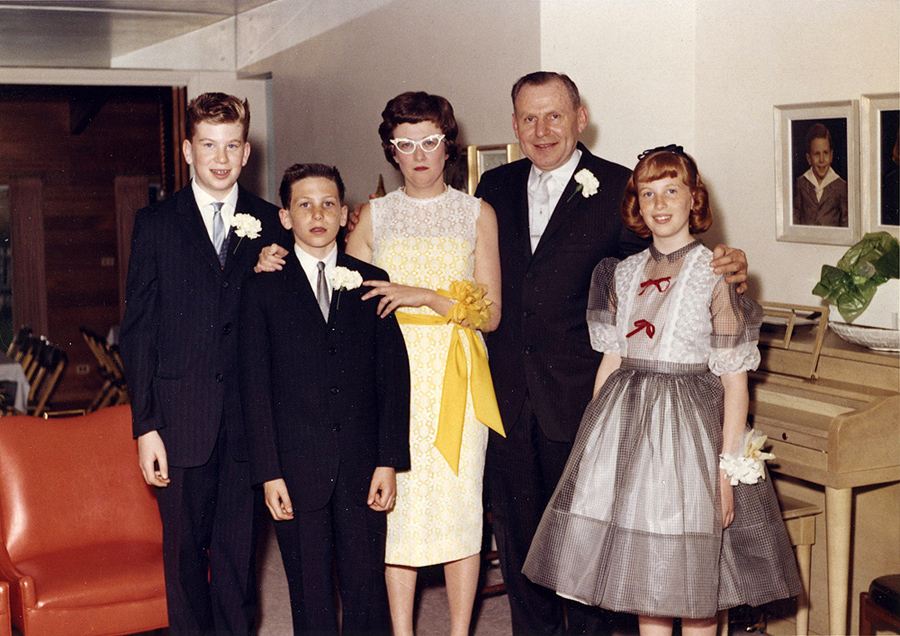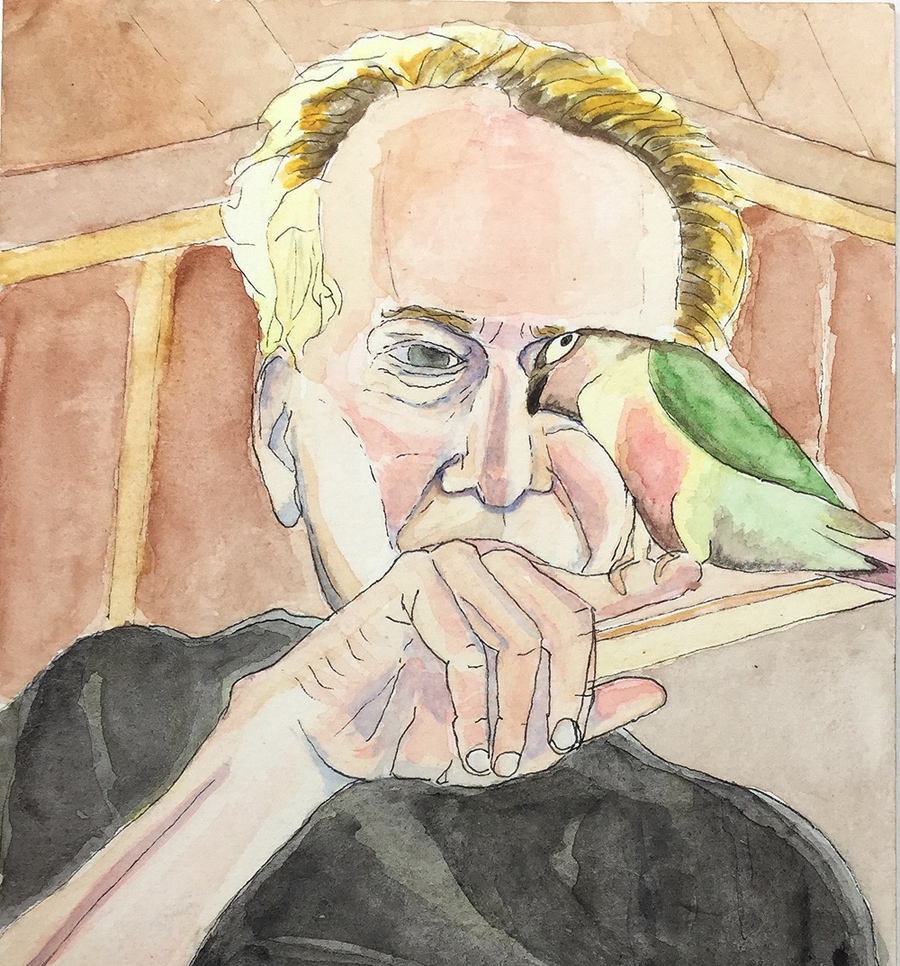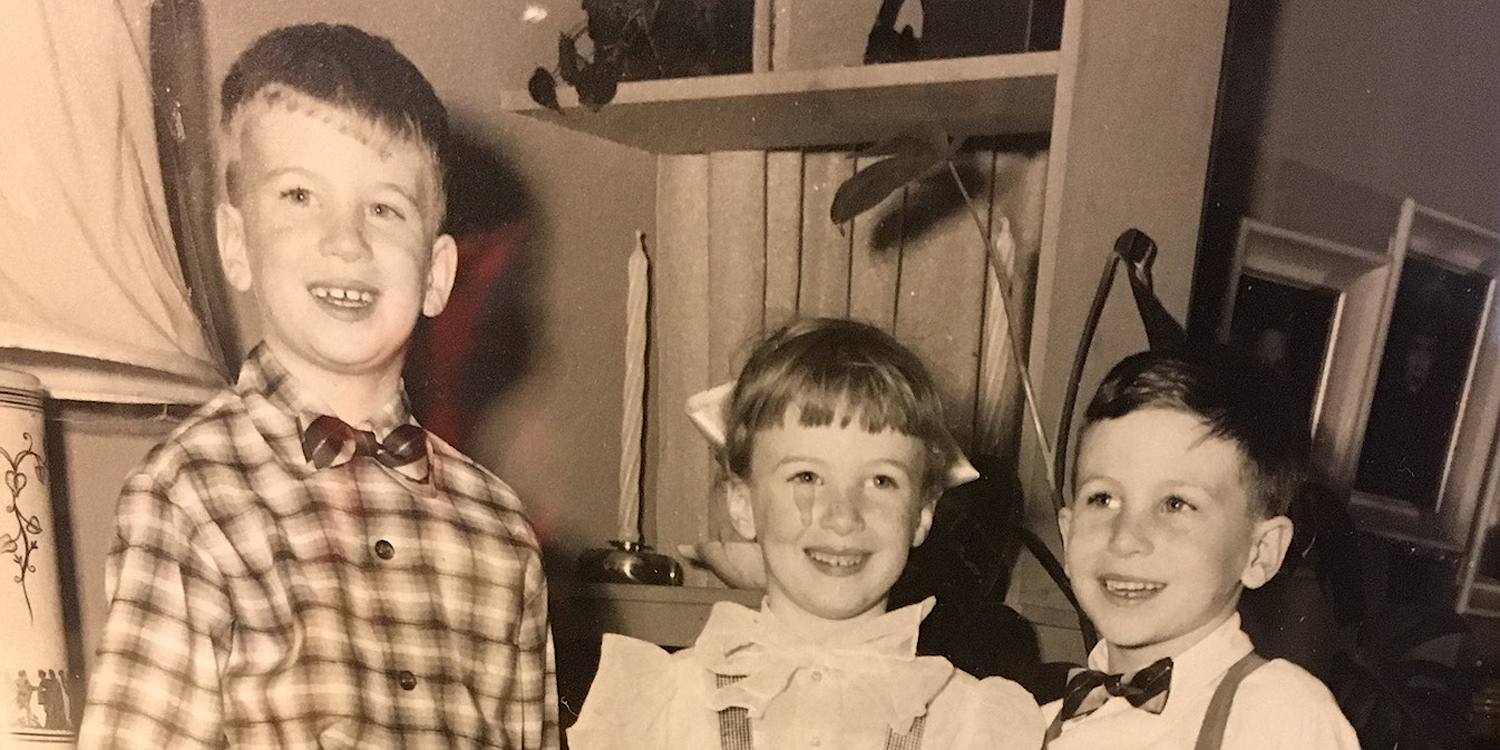I write biographies and magazine profiles. In my dreams, I’m an obituary writer for the New York Times. In reality, I’ve never written an obituary until now. And, at age 69, I never imagined that my debut obit would feature my brother, Richard Greenberg, 71, who died in New York City on Saturday morning, June 16. In his final days in an ICU room at Lenox Hill Hospital, he was, in a way, already buried—in tubes, technology, beeps and buzzes; his thin, handsome blue-eyed head barely visible under the alarmingly ugly white-and-blue breathing tube, one of many devices keeping him alive.
I was the slightly less cynical and decidedly less creative shadow of my brother. He was also my constant confidant. All these decades past, I remember only once being seriously angry with him. That lasted until the next morning because staying angry at him was like staying angry at a toddler. He had a childlike quality that actual children recognized immediately.
When our father died at age 72 in 1988, he acted and looked like an old man. When Dick died at 71, he seemed a boy.
He was a font of visual genius, known mostly for his film titles, the zooming S’s of Superman, the airborn baby in The World According to Garp, the slow-motion opening of Dirty Dancing, the unforgettable sight feast of Alien, Altered States, Death Becomes Her, The Untouchables, Bonfire of the Vanities. In 1988 (working with Stan Winston) he earned an Academy Award nomination for visual effects for Predator. He directed the children’s cult movie Little Monsters, released in 1989.
The late celebrated Saul Bass, graphic designer and filmmaker, said of my brother, “He’s the only guy around whose work I wish I had done.”
Dick, my brother Bob, and I were born, respectively, in Chicago in 1947, ’48, and ’49. We grew up in the homogeneously Jewish neighborhood of West Rogers Park, streets lined with small houses, variations on the same pedestrian theme. (Doctors, dentists, orthodontists and oral surgeons had grander homes with more than one full bath.)
In my earliest memories, Dick opens the door to my tiny bedroom and climbs into my twin bed. “Katie [the name he called me all his life]. I can’t sleep. Let’s talk.” In his right hand was a pen or, worse yet, a smelly permanent maker. He drew on my bed sheets—heads, bodies, dogs, birds, trees, flowers. When he returned to his own bed in the room he shared with Bob, he’d sometimes cut the sheets into strips. I once asked him why and he couldn’t say.

On my birthday, last April 25, he called me at 3:30 a.m. When I answered in annoyance, he said he figured I’d be up. He was right. To this day—and I credit him because I have so many more hours to read—I remain an insomniac. I was re-reading George Eliot’s Middlemarch, a novel we both loved. In later years, he called me several times a day. He told me which movies to see; a week before his death, he texted me that On Chesil Beach was the best movie he had ever seen. Mostly, we talked about books—James Baldwin, Philip Roth, Edith Wharton. And music, lately arguing about the merits of Mahler’s symphonies—I love the 1st; he the darker 5th and 9th.
He was near the end of the process of moving from his house in the Hollywood Hills to a co-op on Manhattan’s Upper East Side. After spending a decade or so in New York, he had settled for—rather than in—Los Angeles in 1991. He told me often how much he hated LA.
He was retired, not because he wanted to be—he was hoping, he said, to work with his friend, director Richard Donner, on another Lethal Weapon film—but because of health problems, some of them with him since birth; poor circulation, a tremor, and mood swings. Over the years, those were exacerbated by a LA doctor who, he told me, prescribed him whatever he wanted; a pharmacy shelf of prescription drugs that sometimes interacted badly with one another, especially when mixed with various street drugs.
He was rushed, periodically, to emergency rooms—on one particularly scary occasion, he decided to stop all his prescription drugs at once. He showed symptoms of a stroke, with slurred speech and a struggle to find words.
A year and a half ago, he was being treated for both drug and sex addiction in a fancy rehab facility in Marin County. At 3 a.m., he decided “enough,” and tried to escape. When a nurse stopped him, he hit her with his walker. He was soon expelled from the facility and he returned to his beach house in Oxnard.
In recent months, his abnormally low oxygen levels turned his fingers, toes, and lips blue and made walking difficult. His posse of doctors in LA couldn’t figure out the cause. He was seeing new doctors in New York and was confident he’d get better and we’d resume the walks we took after he moved to New York in 1977 and he and Bob launched R/Greenberg Associates. It was nothing for us to walk from from 95th and Fifth, where he moved in the ‘80s, to Greenwich Village.
I was 11 when Dick and I walked the alleys of West Rogers Park smoking Marlboros. He was already a heavy smoker and he got me hooked. We were both still students at Rogers, the local elementary school.
He loved arts and crafts, making lanyards, pot holders, ashtrays and bowls for birthday gifts for our parents. His cards were beautiful, complete with moving parts, signed “From Dick.” We were not an expressive or affectionate family. In late elementary school he was housebound with walking pneumonia and he used his time to decorate the house for Hanukah. He made a giant dreidel from cardboard. Not that he had any attachment to anything Jewish. He hated piety, tradition, and religion of all stripes. He didn’t think about death, much less the need for a cemetery plot. He was cremated and his ashes, in an unadorned black box, were taken to his apartment, placed on the fireplace mantle.

We decided to meet there the day after his death because the apartment so reflected his taste. His children, siblings, nieces and nephew, ex-wife sat in a circle telling stories about him, laughing and crying. That was followed by a crowded, one-night Shiva. He would have hated the very sound of the word, and many of the people who crowded his space. The deli food on his antique table, the plastic cups, the flowers on his prized piano, his music (Bach) knocked to the floor, the look of the metal/vinyl-cushioned card chairs brought in for extra seating.
He took “less is more” seriously. In the mid-‘70s before moving to New York, he lived in a Mies van der Rohe building on Lake Shore Drive. My husband and I arrived one afternoon at his apartment to find that he had removed his kitchen appliances. They were outside his front door. He didn’t like the way they looked.
His elementary school teachers informed my mother that Dick had a talent for drawing and painting. They helped her find a Saturday morning class at the Art Institute. He produced portraits that hung in our basement, framed and matted (my father owned a picture frame manufacturing and sales company). His subjects, oddly, included Perry Como and Yul Brenner.
He wore his sensitivity and vulnerability on his beautiful face; he was tall and rail thin. Girls at Sullivan High School, where we all attended, were in love with him. I was a sophomore in high school, after swimming class, putting my wet hair into a ponytail, facing the mirror when a junior he had asked to the prom sidled up next to me and asked me why Dick never “took the next step.” He never moved beyond handholding and, when necessary, kissing, she confessed. I remember blushing and suggesting that maybe he was “scared.”
Back then, in our neighborhood, homosexuality was horrifying, deeply weird, a stain on a family. For as long as I can remember, I knew that Dick was gay. He was an artist; I was a tomboy who loved playing and watching sports, fantasizing that I was a pitcher for the Cubs. I didn’t think much about it.
But my father and my mother did. I once heard him use the word “sissy” while talking to her about Dick. When he was 15 and we were on our annual trip to visit my grandfather in his tiny Washington Heights apartment and then with him to a kosher resort in the Catskill Mountains, we made a stop at West Point. It became clearer to me later that my mother, especially, hoped that Dick would be inspired, by the buzz-cut cadets in their crisp uniforms, and by the gorgeous campus. It was a stunning, stupefying misunderstanding of her son who was unsuited for any aspect of the military.
Later, faced with the Vietnam draft, my parents didn’t do what their neighbors did for the sons—find a doctor to falsely claim a heel spur or flat feet. My father, a World War II army infantry veteran who actually had flat feet, likely thought that getting drafted and going through basic training would “make a man” of Dick.
In 1968, home for the summer from Urbana—he would eventually earn a BA in industrial design and a MFA in graphic design—he was working all night in the basement creating a short anti-violence film to the music of Buffalo Springfield’s “For What It’s Worth,” called, simply, Stop. It was shown at the 1968 Democratic convention in Chicago and won first prize in the student competition of the New York Film Festival. (You can watch it here; scroll down to the question, “And that was your first short film Stop?”)
On another front, he was readying himself for his draft physical by going days without sleep and food, chain smoking Marlboros—his fingers were nicotine-stained yellow—and marijuana. He flunked the physical, never told the military doc that he was gay, which, in those days, would have eliminated the need for all of the above.
My father died in 1988, oblivious to his son’s identity and gifts. Dick eventually told my mother, but while deeply creative herself, she was also deeply conventional and she cared desperately what her friends, neighbors, and relatives would think. She died, also oblivious, in 2009. When I tried to talk to her, she would ask, “Why can’t he just give up this crazy life?” Then she would look away.
Over the years, Dick told me how our parents had hurt him. He told me about his double life at the U of I—a sorority-girl girlfriend to whom he was “pinned” and train trips to Chicago every weekend to meet with friends and lovers in Gold Coast apartments, terrified of running into my parents who then lived nearby in the John Hancock Building.
In New York in the ‘70s, he and Bob built their business, starting on two floors of a walk-up in Murray Hill—previously a whorehouse—where Bob slept in a small closet and Dick slept beneath an animation camera. Under Bob’s direction, the company expanded; it's currently located in the Hudson Yards with 2,000 staffers and 18 offices around the world. Meanwhile, Dick lived the life of a gay man.
In 1979, Dick married, and his children were born in the early ‘80s. Part time, he lived the life of a wealthy New Yorker—Fifth Avenue co-op, a retinue of nannies and housekeepers, an historic house in Connecticut. The other part he lived in the closet.
In 1991, he and his family moved to Los Angeles. His R/GA partnership broke up, he cycled through depression, mania, and fury. He became careless about his liaisons, once having sex in the marital bed in Santa Monica. Divorce followed. He loved his children, but he did not know how to be a father, and was grumpy about giving time when the activity was not something he enjoyed. He particularly hated going to his sons’ soccer games. He would call me from the field to complain.
He took huge health risks. He saw a dermatologist more times in a year than most people see in their lifetimes. He had several melanomas. The doc would cut it out, check the margins, cut some more, stitch him up—he’d call me from the surgical table between pathology reports—and he’d return home to bake in the sun. When I asked him why, he said the sun made the incision dry out and would turn it “crispy.”
The one man whom he truly loved died. His drug use escalated to bouts with crystal meth; drug interactions landed him in the hospital and rehab. The man who loved a brisk walk, a lively conversation, and almost any kind of food, could barely manage to walk from the door of the taxi to the pizza restaurant in Brooklyn.
Oddly given the dark pockets of his life, what ended up killing him was the most pedestrian of medical emergencies: a burst appendix.
My husband and I had a date to meet him at his apartment, which I was to see for the first time; its kitchen open shelving full of his antique bird cages and beautiful bowls. (He liked birds, and kept—all uncaged—African Grays, eight doves, and two parrots, Monique and Baby. He also had a cat for awhile, that might or might not have harmed the birds, and three pugs.)

When we arrived he appeared at the door disheveled and in his underwear. He said he had a “stomach migraine” and couldn’t join us but we should keep the reservation and we’d love the restaurant.
When I called him the next day he felt better. The docs explained that once the appendix exploded—they described his as exploded, not just burst—the pain ends. The next Tuesday, his housekeeper warned his daughter that he hadn’t eaten or gotten out of bed in three days. By the time he was delivered by ambulance to the ER, just a block from his apartment, he was near death. Part of his intestine was removed, his kidneys shut down, and his prognosis was grim.
Coincidentally, just days before, my husband, an attorney and lifelong friend of Dick’s, had drawn up the power of attorney for health care form. I was it, and, with his children, made the decision to withdraw life support.
His son put his cell phone playing Mahler’s 5th and then 9th in bed with him as, one by one, the machines keeping him alive were disconnected. I suggested we give Mahler’s 1st a try, and he seemed to perk up to the music. The nurses told us he was only barely conscious and might be aware we were there but not much more.
I walked back to the family visiting room and couldn’t sit still, so I returned to the corridor crowded with equipment, making my way to the last room on the left—his. His children were stroking his skin and hair and telling him how much they loved him. They motioned me in.
His legs were so long—he was 6’ 3, most of that legs—that his hospital bed could not really contain him. His feet and ankles stuck out, so blue that they resembled the feet of a mummy in a museum exhibit.
One of his sons told me to hold his left hand, the fingers once elegantly thin, now bloated, his eyes half opened, the eyeballs rolled back. I loudly repeated the name I called him always, “Dickie. It’s Katie. I’m here.” He squeezed my hand, squeezed it so hard that he left a welt on my ring finger. I started to withdraw and he squeezed it harder and more urgently. He’s hanging on to me for dear life, I thought. What have I done? The effort must have been exhausting or perhaps it was the morphine drip. I left. One of his sons stayed with him all night. He died nine hours later.




Comments are closed.